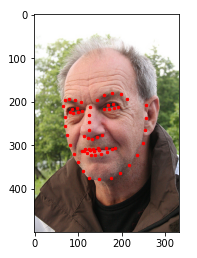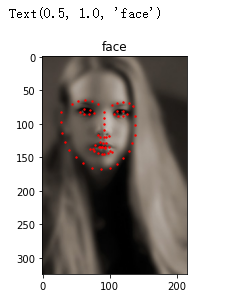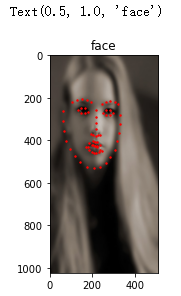前言
pytorch作为一款深度学习框架,已经帮助我们实现了很多很多的功能了,包括数据的读取和转换了,那么这一章节就介绍一下pytorch内置的数据读取模块吧
模块介绍
- pandas 用于方便操作含有字符串的表文件,如csv
- zipfile python内置的文件解压包
- cv2 用于图片处理的模块,读入的图片模块为bgr,n h w c
- torchvision.transforms 用于图片的操作库,比如随机裁剪、缩放、模糊等等,可用于数据的增广,但也不仅限于内置的图片操作,也可以自行进行图片数据的操作,这章也会讲解
- torch.utils.data.dataset torch内置的对象类型
- torch.utils.data.dataloader 和dataset配合使用可以实现数据的加速读取和随机读取等等功能
|
1
2
3
4
5
6
7
8
|
import zipfile # 解压import pandas as pd # 操作数据import os # 操作文件或文件夹import cv2 # 图像操作库import matplotlib.pyplot as plt # 图像展示库from torch.utils.data import dataset # pytorch内置对象from torchvision import transforms # 图像增广转换库 pytorch内置import torch |
初步读取数据
数据下载到
我们先初步编写一个脚本来实现图片的展示
|
1
2
3
4
5
6
7
8
9
10
11
12
13
14
15
16
17
18
19
20
21
22
|
# 解压文件到指定目录def unzip_file(root_path, filename): full_path = os.path.join(root_path, filename) file = zipfile.zipfile(full_path) file.extractall(root_path)unzip_file(root_path, zip_filename)# 读入csv文件face_landmarks = pd.read_csv(os.path.join(extract_path, csv_filename))# pandas读出的数据如想要操作索引 使用ilocimage_name = face_landmarks.iloc[:,0]landmarks = face_landmarks.iloc[:,1:]# 展示def show_face(extract_path, image_file, face_landmark): plt.imshow(plt.imread(os.path.join(extract_path, image_file)), cmap='gray') point_x = face_landmark.to_numpy()[0::2] point_y = face_landmark.to_numpy()[1::2] plt.scatter(point_x, point_y, c='r', s=6) show_face(extract_path, image_name.iloc[1], landmarks.iloc[1]) |

使用内置库来实现
实现mydataset
使用内置库是我们的代码更加的规范,并且可读性也大大增加
继承dataset,需要我们实现的有两个地方:
-
实现
__len__返回数据的长度,实例化调用len()时返回 -
__getitem__给定数据的索引返回对应索引的数据如:a[0] -
transform数据的额外操作时调用
|
1
2
3
4
5
6
7
8
9
10
11
12
13
14
15
16
17
18
19
|
class facedataset(dataset): def __init__(self, extract_path, csv_filename, transform=none): super(facedataset, self).__init__() self.extract_path = extract_path self.csv_filename = csv_filename self.transform = transform self.face_landmarks = pd.read_csv(os.path.join(extract_path, csv_filename)) def __len__(self): return len(self.face_landmarks) def __getitem__(self, idx): image_name = self.face_landmarks.iloc[idx,0] landmarks = self.face_landmarks.iloc[idx,1:].astype('float32') point_x = landmarks.to_numpy()[0::2] point_y = landmarks.to_numpy()[1::2] image = plt.imread(os.path.join(self.extract_path, image_name)) sample = {'image':image, 'point_x':point_x, 'point_y':point_y} if self.transform is not none: sample = self.transform(sample) return sample |
测试功能是否正常
|
1
2
3
4
5
|
face_dataset = facedataset(extract_path, csv_filename)sample = face_dataset[0]plt.imshow(sample['image'], cmap='gray')plt.scatter(sample['point_x'], sample['point_y'], c='r', s=2)plt.title('face') |

实现自己的数据处理模块
内置的在torchvision.transforms模块下,由于我们的数据结构不能满足内置模块的要求,我们就必须自己实现
图片的缩放,由于缩放后人脸的标注位置也应该发生对应的变化,所以要自己实现对应的变化
|
1
2
3
4
5
6
7
8
9
10
11
12
|
class rescale(object): def __init__(self, out_size): assert isinstance(out_size,tuple) or isinstance(out_size,int), 'out size isinstance int or tuple' self.out_size = out_size def __call__(self, sample): image, point_x, point_y = sample['image'], sample['point_x'], sample['point_y'] new_h, new_w = self.out_size if isinstance(self.out_size,tuple) else (self.out_size, self.out_size) new_image = cv2.resize(image,(new_w, new_h)) h, w = image.shape[0:2] new_y = new_h / h * point_y new_x = new_w / w * point_x return {'image':new_image, 'point_x':new_x, 'point_y':new_y} |
将数据转换为torch认识的数据格式因此,就必须转换为tensor
注意: cv2和matplotlib读出的图片默认的shape为n h w c,而torch默认接受的是n c h w因此使用tanspose转换维度,torch转换多维度使用permute
|
1
2
3
4
5
|
class totensor(object): def __call__(self, sample): image, point_x, point_y = sample['image'], sample['point_x'], sample['point_y'] new_image = image.transpose((2,0,1)) return {'image':torch.from_numpy(new_image), 'point_x':torch.from_numpy(point_x), 'point_y':torch.from_numpy(point_y)} |
测试
|
1
2
3
4
5
6
|
transform = transforms.compose([rescale((1024, 512)), totensor()])face_dataset = facedataset(extract_path, csv_filename, transform=transform)sample = face_dataset[0]plt.imshow(sample['image'].permute((1,2,0)), cmap='gray')plt.scatter(sample['point_x'], sample['point_y'], c='r', s=2)plt.title('face') |

使用torch内置的loader加速读取数据
|
1
2
3
4
|
data_loader = dataloader(face_dataset, batch_size=4, shuffle=true, num_workers=0)for i in data_loader: print(i['image'].shape) break |
|
1
|
torch.size([4, 3, 1024, 512]) |
注意: windows环境尽量不使用num_workers会发生报错
总结
这节使用内置的数据读取模块,帮助我们规范代码,也帮助我们简化代码,加速读取数据也可以加速训练,数据的增广可以大大的增加我们的训练精度,所以本节也是训练中比较重要环节
到此这篇关于pytorch数据读取的实现示例的文章就介绍到这了,更多相关pytorch数据读取内容请搜索服务器之家以前的文章或继续浏览下面的相关文章希望大家以后多多支持服务器之家!
原文链接:https://blog.csdn.net/weixin_42263486/article/details/108295120










